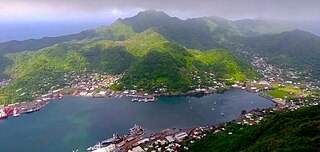
Pago Pago is the capital of American Samoa. It is in Maoputasi County on Tutuila, which is American Samoa's main island.
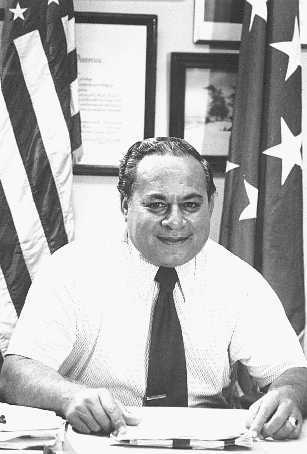
Peter Tali Coleman was an American Samoan politician and lawyer. Coleman was the first and only person of Samoan descent to be appointed governor of American Samoa between 1956 and 1961 and later became the territory's first and third popularly elected governor from 1978 to 1985 and 1989 to 1993, serving a total of three elected terms. In between, he had served in different administrative positions for Pacific islands.

The University of the South Pacific (USP) is a public research university with locations spread throughout a dozen countries in Oceania. Established in 1968, the university is organised as an intergovernmental organisation and is owned by the governments of 12 Pacific island countries: the Cook Islands, Fiji, Kiribati, Marshall Islands, Nauru, Niue, Samoa, Solomon Islands, Tokelau, Tonga, Tuvalu and Vanuatu.
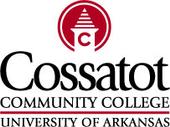
Cossatot Community College of the University of Arkansas (CCCUA) is a public community college serving southwest Arkansas. Its main campus is located in the foothills of the Ouachita Mountains in De Queen, Arkansas.
Utulei or ʻUtulei is a village in Maoputasi County, in the Eastern District of Tutuila, the main island of American Samoa. Utulei is traditionally considered to be a section of Fagatogo village, the legislative capital of American Samoa, and is located on the southwest edge of Pago Pago Harbor. Utulei is the site of many local landmarks: The A. P. Lutali Executive Office Building, which is next to the Feleti Barstow Library; paved roads that wind up to a former cablecar terminal on Solo Hill; the governor's mansion, which sits on Mauga o Alii, overlooking the entrance to Goat's Island, and the lieutenant governor's residence directly downhill from it; the Lee Auditorium, built in 1962; American Samoa's television studios, known as the Michael J. Kirwan Educational Television Center; and the Rainmaker Hotel. Utulei Terminal offers views of Rainmaker Mountain.
Harry S Truman College or Truman College, formerly called Mayfair College, is a part of City Colleges of Chicago. It offers multiple 2-year associate degrees, as well as occupational training in a number of fields. Located at 1145 West Wilson Avenue in the Uptown neighborhood, the school was named in honor of Harry S. Truman, 33rd U.S. President and a proponent of public colleges and universities. Truman is the largest of the City Colleges of Chicago with a yearly enrollment of over 23,000 students, and has the largest English as a second language and GED program in Illinois.
Mapusaga is a small village located 9 miles (14 km) west of Pago Pago on Tutuila island in the American territory of American Samoa. Its coordinates are 14.33° south and 170.74389 ° west, with an elevation of 180 feet (55 m). The village is home to American Samoa Community College. An area in the village is called Mapusagafou, which translates to New Mapusaga. Another area in town is known as Mapusagatuai, meaning Old Mapusaga.

The American Samoa Department of Public Safety, formerly the American Samoa Territorial Police, is the police law enforcement agency for American Samoa, which has jurisdiction anywhere in the territory. It was created to protect the lives and property of American Samoans. The DPS has police, corrections and fire divisions.

The National University of Samoa is the only national university in Samoa. Established in 1984 by an act of parliament, it is coeducational and provides certificate, diploma, and undergraduate degree programs, as well as technical and vocational training. About 2,000 students were enrolled in 2010 with an estimated 300 staff. It offers a wide range of programmes including Arts, Business and Entrepreneurship, Education, Science, Nursing, Engineering and Maritime Training. The Centre for Samoan Studies, established in the university for the teaching of the Samoan language and culture, offers undergraduate and graduate degrees as well as the world's first degree in Master of Samoan Studies.

The American Samoa Power Authority (ASPA) is a government-run public utility company providing electricity, water, wasterwater, and waste disposal services within American Samoa.
Anua is a village on Tutuila Island, American Samoa. It is located close to the capital Pago Pago, on the coast of Pago Pago Harbor. The term Pago Pago is often used for several settlements on Pago Pago Bay, including Anua, Lepua, Utulei, and others.

Samoa College is a secondary school in Samoa officially opened in 1953. It is co-educational and teaches from years 9 to 13. It is in Apia on the island of Upolu and is considered the main college in the country. The early college and curriculum was modeled on secondary schools in New Zealand, reflecting the country's colonial history.

The Pacific Theological College (PTC) is an ecumenical theological college located in Suva, Fiji. Established in 1965, it opened for training in 1966 and was originally designed as the only regional institution to offer degree-level education in theology, available primarily to students from Pacific Island churches. Many of the church leaders of the Pacific Islands have been educated at PTC since.

Leone High School is a senior high school in Vailoatai and Leone, in the Western District, American Samoa. It is operated by the American Samoa Department of Education. It is the second-largest high school on Tutuila Island.
The Governor H. Rex Lee Auditorium, also called Fale Laumei in Samoan, is the largest indoor meeting space in the United States territory of American Samoa. It is located in the village of Utulei, surrounded by other government buildings. The main body of the building is a roughly ovoid structure, with a curved roof that is reminiscent of the thatch roofs of traditional Samoan structures. The auditorium was built in 1962 under orders from Governor Hyrum Rex Lee as part of a major initiative to modernize the territory's infrastructure and facilities. It was built by a construction squadron of the United States Navy, and was completed in time for the 1962 South Pacific Conference. It was later named in honor of Lee, who was the territory's longest-serving governor, and oversaw much of its modernization.
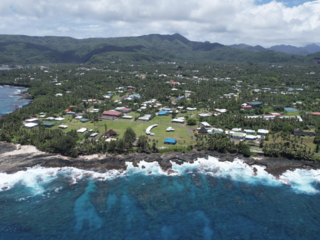
Vailoatai is a village in southwestern Tutuila, the main island of American Samoa. It is located on the eastern end of Leone Bay. The village is known for its beautiful malae, nested along the island's rugged southern coast and lined by the fale tali mālō of its village chiefs.

Nauru Secondary School is an upper public secondary school in the Yaren District, Nauru, located in the Nauru Learning Village, along with the University of the South Pacific Nauru Campus and the Nauru Technical & Vocational Education Training Centre.

Lyndon B. Johnson Tropical Medical Center is the only hospital in American Samoa, and is located in Faga'alu, Maoputasi County. It has been ranked among the best hospitals in the Pacific Ocean. It is home to an emergency room and there are doctors on duty at all hours. It is a 150-bed facility. It includes TB, leprosy and obstetric units. The hospital was built in 1968 and is operating under a $50 million budget as of 2017. The executive director is Taufete'e John Faumuina.
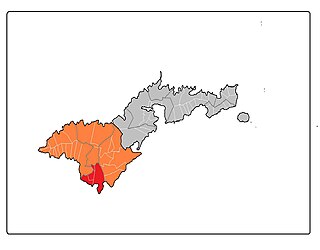
Tuālā-tai County is one of the five counties that make up the Western District of American Samoa.
Itūʻau, together with Aitūlagi, make up the village of Malaeloa.
















